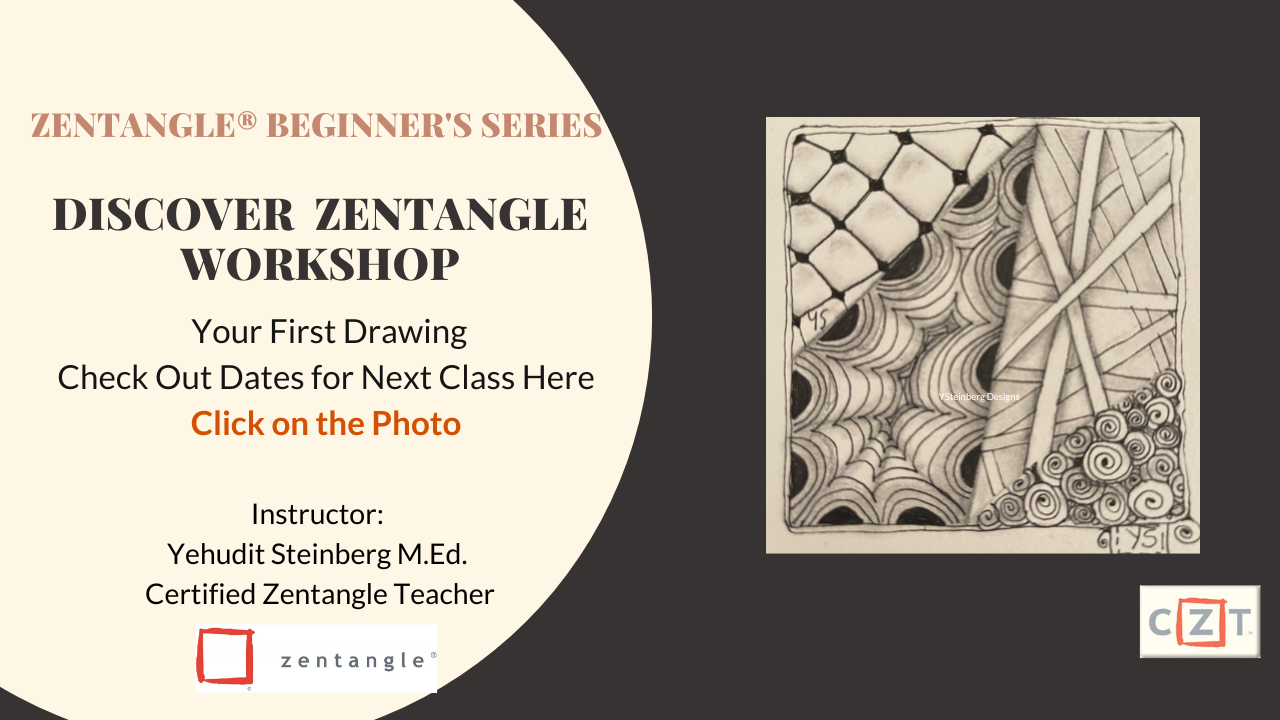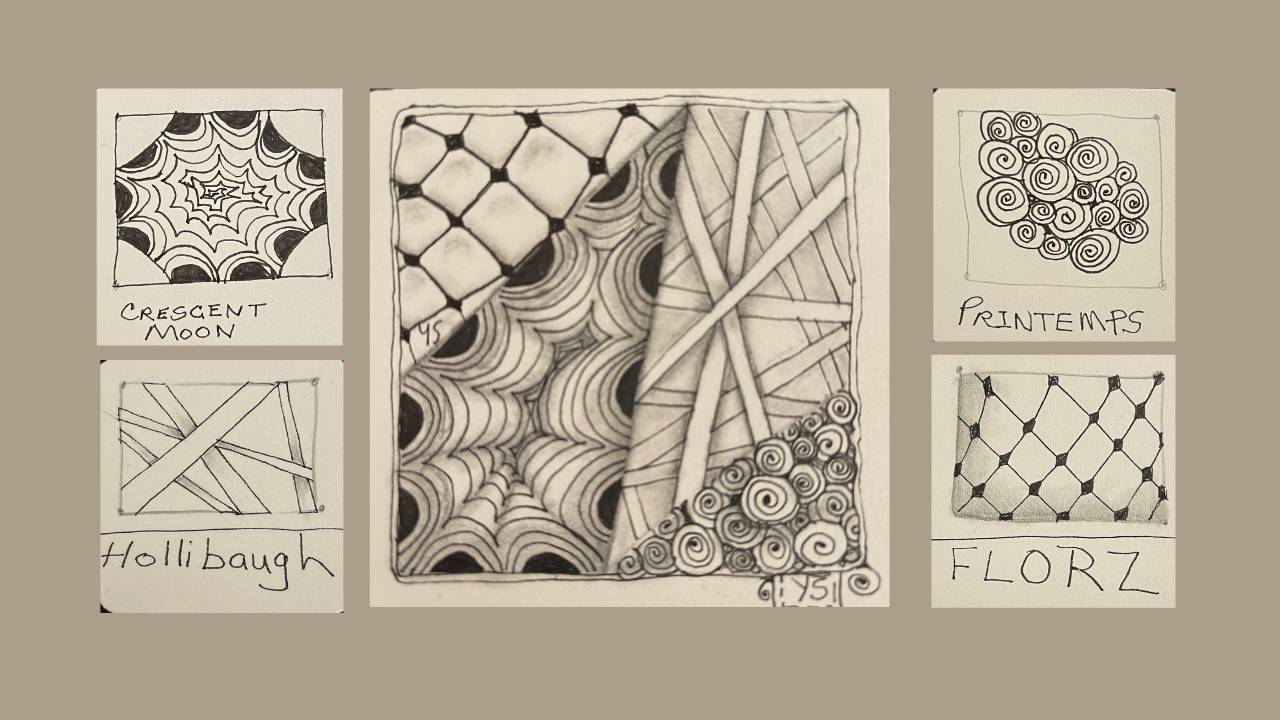
5 Easy Zentangle Patterns for Beginners Step by Step

Is the Zentangle® Method For You?
If you are looking for a relaxing and creative way to start your day in a focused and creative manner, or unwind after a long day, Zentangle might be just the thing for you. Zentangle is a meditative art form that involves drawing repetitive patterns to create beautiful and intricate designs. It's a relaxing and enjoyable practice that can help reduce stress and promote mindfulness. If you're new to Zentangle, it's important to start with some easy patterns to build your skills and confidence. In this post, we'll guide you through five beginner patterns called tangles, step by step.
Zentangle Vocabulary 101:
Key Terms Every Beginner Zentangler Should Know
The founders of Zentangle decided to create its own language called Zentology to create a common language and understanding among those practicing the Zentangle method, no matter where they are in the world.
- "Tangle" - noun A tangle is a deconstructed pattern used in Zentangle Method that is recreated by drawing its predefined sequence of elemental strokes. Each tangle has a specific name.
- "Step-out"- A graphic representation of the specific sequence of elemental strokes used to draw a particular tangle. Usually made from 1-3 elemental strokes.
- "String" - A string is a light pencil line drawn on the paper to provide a basic structure for a Zentangle.
- "Tile" - A tile is a small, square piece of paper on which Zentangle art is created. See tile example below.
- "Aura" - An aura in Zentangle is a line that runs parallel to an existing line or tangle and follows its shape, resembling a ripple in a pond or a halo around the tangle.
- "Shading" - Shading is the technique of using pencil to add depth and dimension to a Zentangle by creating areas of light and shadow.
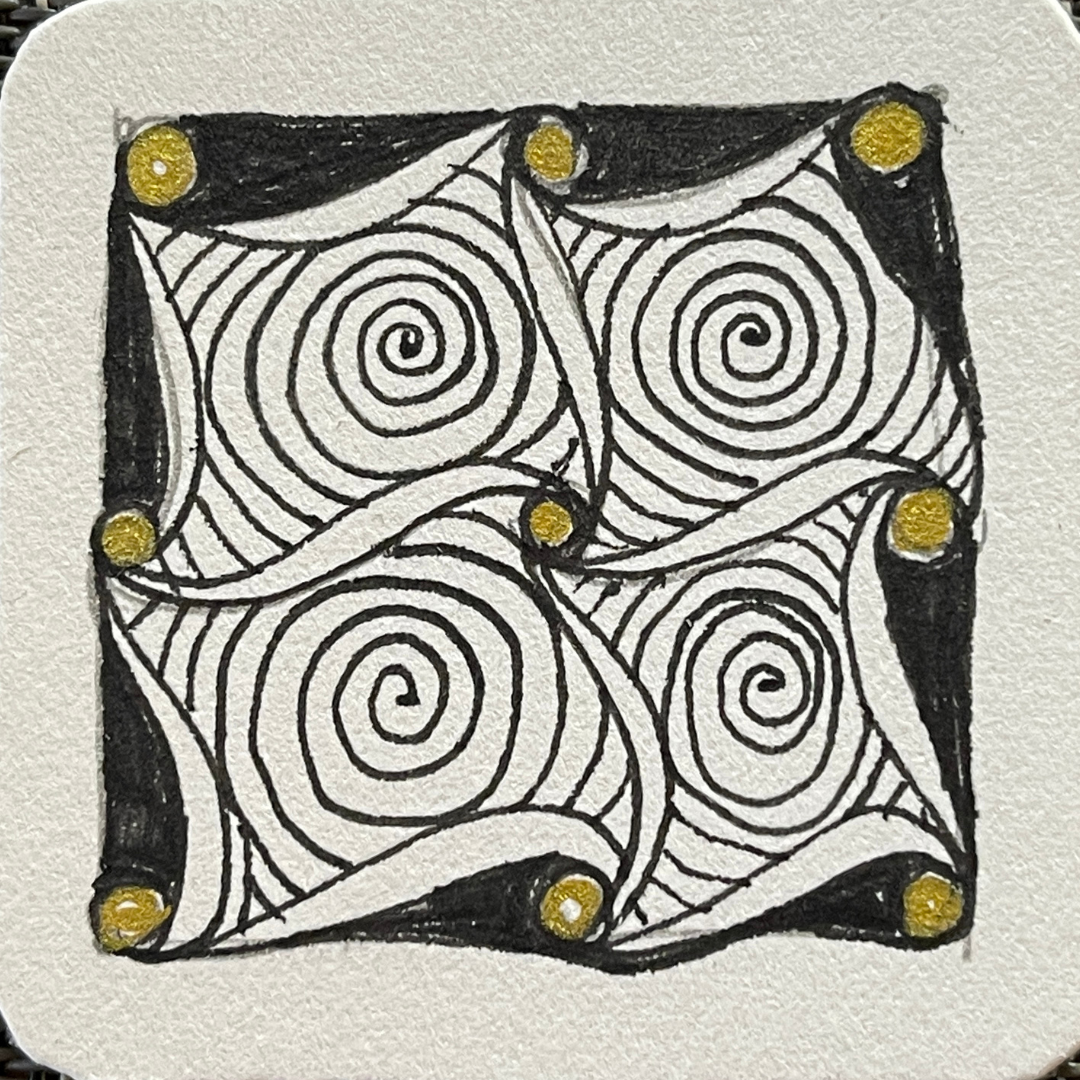
Importance of Learning Beginner Patterns
While Zentangle can be a simple and accessible art form, it can also be intimidating for beginners.
The Zentangle method has gained popularity in recent years, and it is important to be mindful of misinformation that may be circulating on the internet. It's understandable that people are eager to share their experiences and knowledge, but it's important to recognize that not all information may be accurate or aligned with the fundamental principles of the Zentangle ® practice. Therefore, seeking guidance from a Certified Zentangle Teacher can help ensure a deeper understanding and appreciation of this technique.
Here are 5 Reasons Why You Want To Study the basic easy beginner tangles first and it's recommended to take an Introductory class with a CZT to get started on a firm foundation.
- Build Confidence: Starting with easy Zentangle patterns will help build your confidence as a beginner. It allows you to create a finished artwork without feeling overwhelmed or frustrated, which in turn motivates you to continue learning.
- Learn Basic Techniques: Easy Zentangle patterns teach you the fundamental techniques that you'll use to create more complex patterns later on. By mastering these basic techniques, you'll have a solid foundation to build upon
- Develop Muscle Memory: By practicing easy Zentangle patterns repeatedly, you'll develop muscle memory that will help you draw with ease and precision. This muscle memory will come in handy as you progress to more intricate designs.
- Understand Tangle Structure: Easy Zentangle patterns demonstrate the underlying structure of tangles. As you learn more about tangle structure, you'll be able to create your own unique patterns and incorporate them into your artwork.
- Enjoy the Process: Above all, learning easy Zentangle patterns allows you to enjoy the process of creating art without the pressure of creating a perfect piece. You'll learn to appreciate the beauty in imperfection and embrace the meditative aspect of Zentangle.
5 Easy Zentangle Patterns
In this article, we will provide step-by-step instructions for 5 easy Zentangle patterns that are perfect for beginners.
Pattern #1: Crescent Moon
Core Pattern for drawing halos (Aura-ing)
Crescent Moon is typically the first pattern (tangle) a student learns from a Certified Zentangle Teacher. It is a great tangle to start with. The main reason for this is that it teaches the fundamental principle of the Zentangle Method called Aura. An aura is a line that traces a halo around or inside another line, exactly mimicking the character of the previously drawn line. Auras are used in many patterns and drawings (tiles). Every pattern (tangle in zentanglese) has infinite possibilities using other tangles with the main pattern you are drawing.
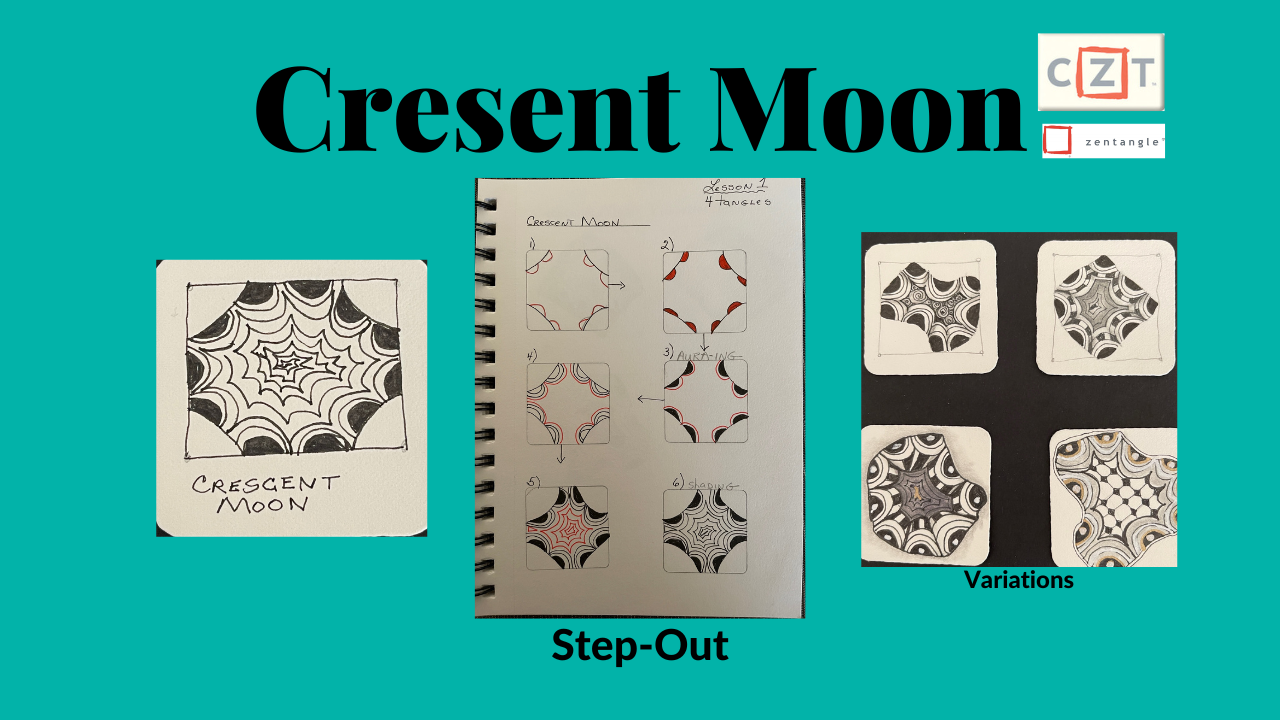
Crescent Moon is a pattern that involves drawing half-moon C shapes in a row. Here's a few examples and the Step-Out. A Step-Out in Zentangle is a step by step, line by line visual representation of how the pattern fits together. The red lines are the new line added.
Variations and modifications: Experiment with different sizes and shapes of half-moons, or try adding color to the pattern.
What is a Zentangle Step-Out?
Zentangle step out is a pattern-making prompt used in the Zentangle method, which involves adding one line at a time to create intricate designs. The new line to be drawn is usually marked in red and there are typically no more than six steps to complete a pattern. This allows people of all skill levels to easily follow and create beautiful Zentangle designs. Zentangle step outs are often provided in the form of visual guides, with each step illustrated in detail to help the artist recreate the pattern accurately.
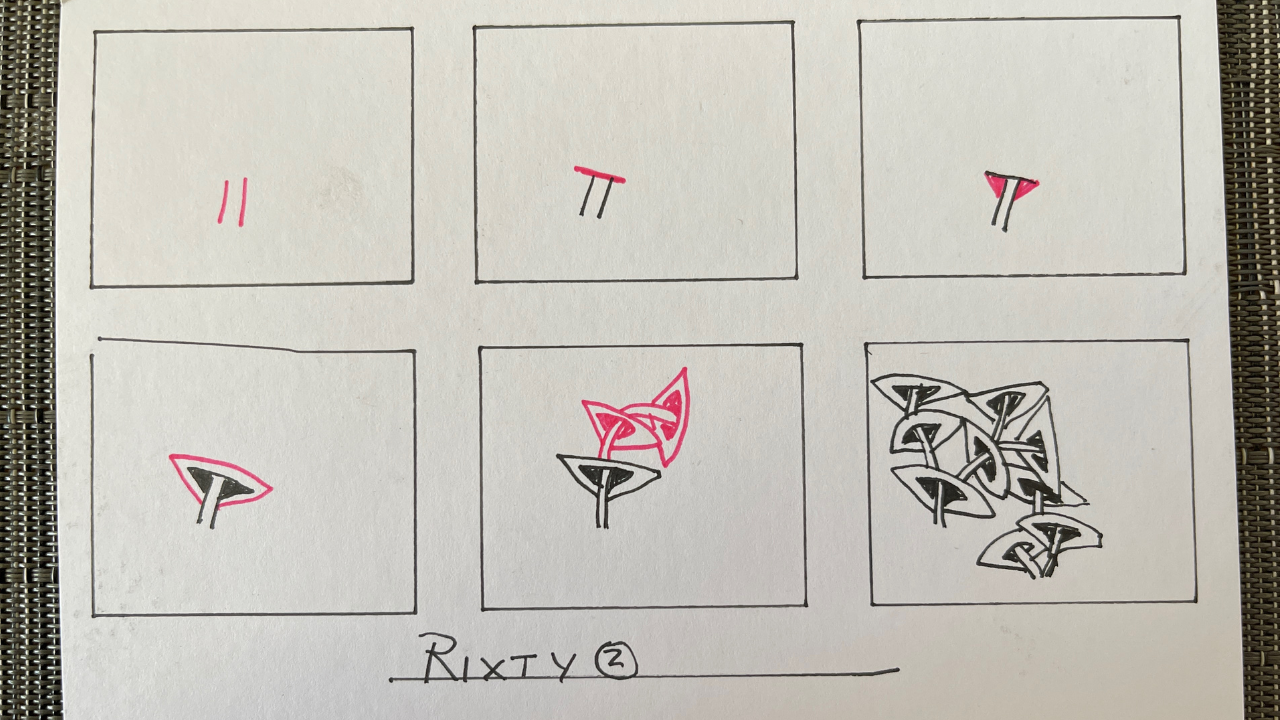
An example of the Step Outs on a 5x7 card I use for my Step-Out Card Index. At a future date, I'll create a video on my Youtube Channel that walks you through step by step how to set up your Step Out file. It comes in handy as a visual representation on how to create a pattern, at your fingertips, saving you a lot of time searching for a step out every time you want to draw this pattern.
Pattern #2: Hollibaugh
Basic Pattern for Drawing Over and Under
The next tangle you are drawing is called Hollibaugh. This is also a tangle we routinely use in a beginner class. Hollibaugh also teaches a fundamental principle of the Zentangle Method. We call this principle “drawing behind”.

“Drawing behind is when you draw a line and then momentarily discontinue drawing it when that line intersects a previously drawn shape. Every pattern (tangle in zentanglese) has infinite possibilities using other tangles with the main pattern you are drawing.
Pattern #3: Printemps
Printemps is (French for the season of spring)
Printemps is a simple spiral tangle, whose iconic and repetitive shape, provides an easy point of focus and tangling pleasure. This shape appears throughout nature. It's a simple curvilinear pattern.
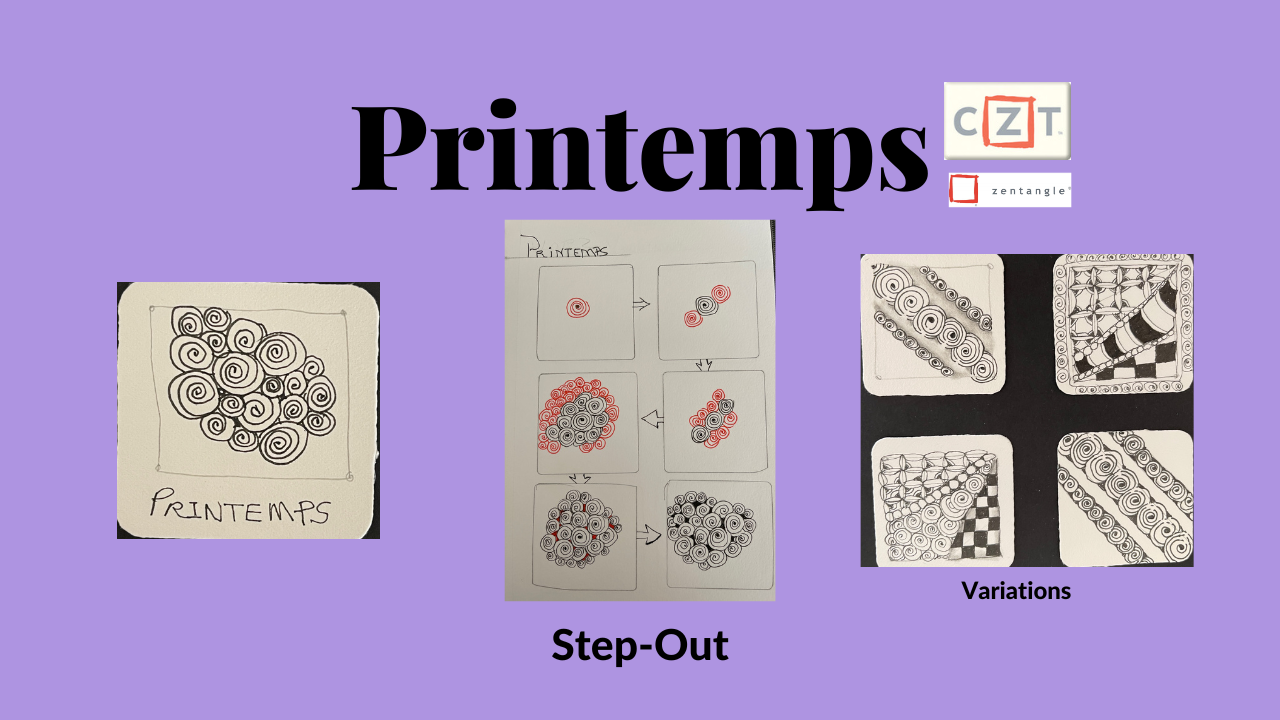
Every pattern (tangle in zentanglese) has infinite possibilities using other tangles with the main pattern you are drawing. 4 examples of PRINTEMPS variations
Pattern #4: Florz
Basic Grid Pattern introduced during beginning lesson
Florz is a crisp, uncomplicated tangle pattern to draw. But oh so versatile. It can be varied in many ways – with curved or straight lines, different shapes where the lines intersect, shading, and filling in the white space with other design work.

Florz was inspired by the beautiful black and white tile floor in Rick and Maria’s vintage home, Maria writes “It’s one of the first things I see every morning. Every pattern (tangle in zentanglese) has infinite possibilities using other tangles with the main pattern you are drawing. 4 examples of FLORZ variations.
Pattern #5: Tipple
Using the elemental line of a closed, symmetrical circle or orb.
Tipple is a basic Zentangle pattern that consists of small, evenly spaced dots or circles. It is one of the original 102 Zentangle®-original tangle patterns, These dots can be arranged in a random or structured pattern, depending on the artist's preference.

Tipple is often used as a filler pattern to add texture and depth to Zentangle designs, and it can be combined with other patterns to create more complex compositions. The name "Tipple" is a play on words, as it sounds like "dimple" or "pimple," which describes the small circular shapes used in the pattern
Ready to take your Zentangle skills to the next level?
Here are 5 reasons why you should consider the Discover Zentangle workshop:
1) Learn the 8 Step Zentangle® Method, your key to consistent zen flow
2) Explore variations with these 5 patterns and experience Zentangle's magical moments
3) Connect with a supportive community and get your questions answered.
4) Enhance your creativity
5) Relax and destress.
Click on the image learn more and schedule your class.
What is Zentangle?
Zentangle was created by Rick Roberts and Maria Thomas in 2003 as a way to help people focus and relax. The process involves drawing patterns, called "tangles," on small pieces of paper using a pen or pencil. The patterns are typically made up of simple, repetitive strokes that can be combined to create complex designs. For an in-depth interview with the Zentangle founders check out this 1 hr long in depth Youtube video including the origin story of How Zentangle Began.
For more in depth background on Zentangle read our What is Zentangle blog post.
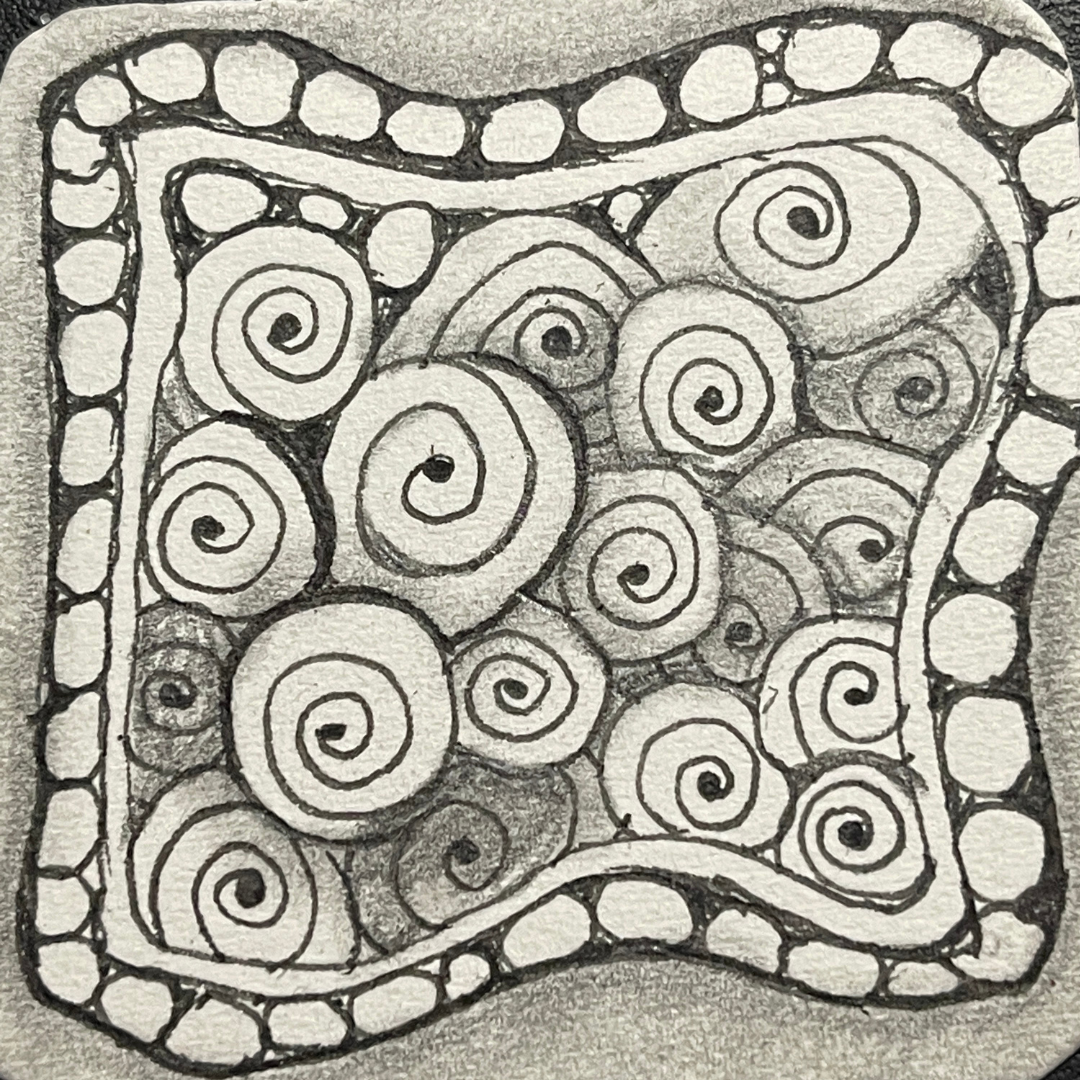
Benefits of Zentangle
Zentangle has been shown to have a number of benefits for both physical and mental health.
- Meditative: The repetitive strokes and patterns of Zentangle can help quiet the mind and promote relaxation.
- Focus: Creating Zentangle patterns can improve concentration and attention to detail, which can be useful in other areas of life.
- Creative: Zentangle is a highly creative activity, allowing you to explore different patterns and color schemes to create unique pieces of art.
- Grounding: The act of creating something with your hands can be a grounding and calming experience.
- Self-expression: Zentangle provides a way to express yourself and tap into your creativity without pressure to create something perfect.
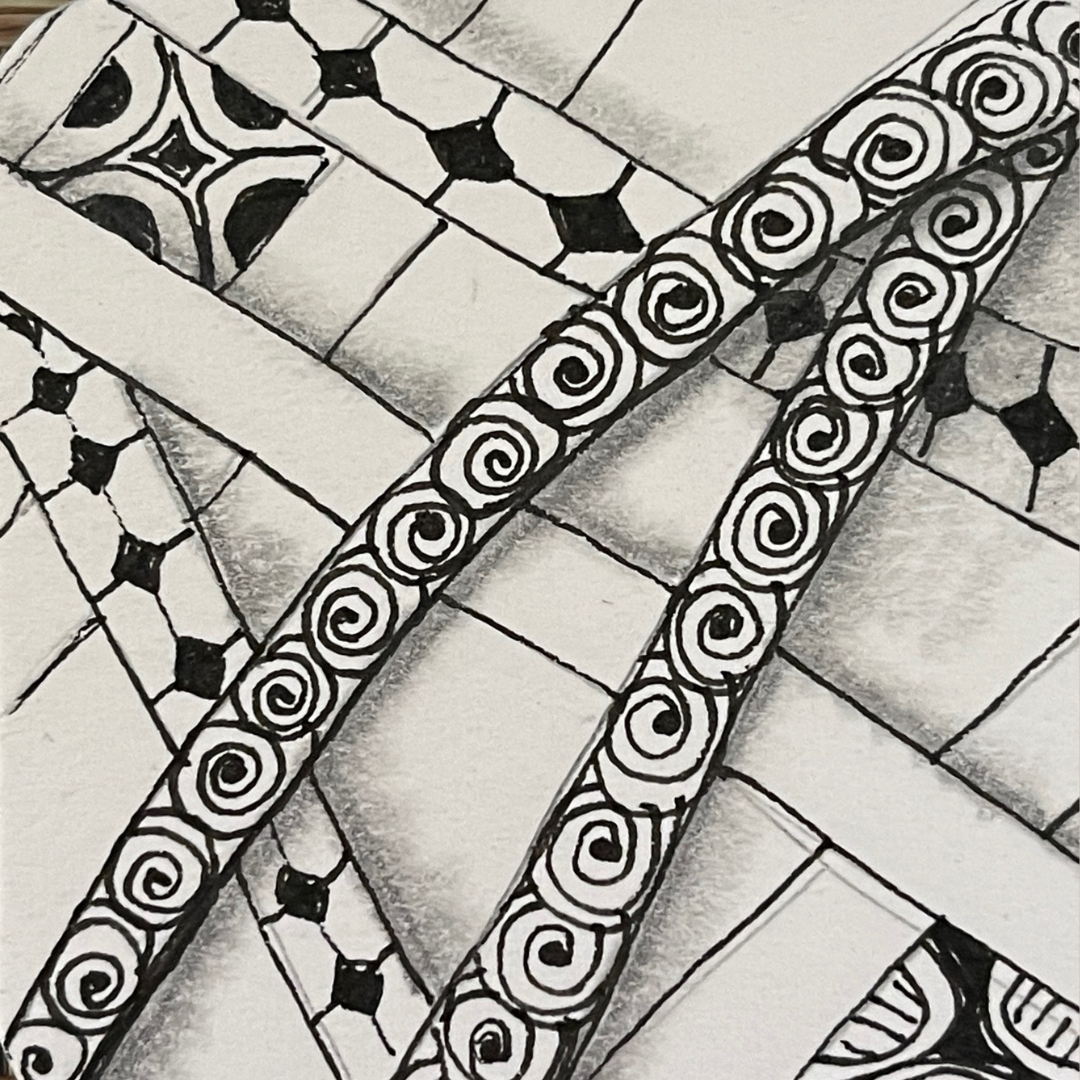
FAQ for Beginners
If you're new to Zentangle, you may have some questions about this unique art form.
Here are some common FAQs to help you get started.
A. What is Zentangle and how is it different from doodling?
Zentangle is a method of creating art through the use of repetitive patterns and deliberate strokes. While it may resemble doodling, Zentangle is a more focused and intentional practice, with the goal of promoting relaxation, mindfulness, and self-expression.
B. Do I need to have artistic talent to do Zentangle?
No artistic talent is required to do Zentangle. The beauty of this practice is that it is accessible to everyone, regardless of age, background, or artistic ability. By starting with simple patterns and practicing regularly, anyone can develop their skills and creativity.
C. Can I use regular paper and pens or do I need special supplies?
While specialized Zentangle supplies, such as Micron pens and Zentangle tiles, can enhance the experience and quality of the artwork, they are not required. Regular paper and pens can be used to create beautiful and unique Zentangle designs, and many artists enjoy experimenting with different materials.
D. How long does it take to complete a Zentangle drawing?
The length of time it takes to complete a Zentangle drawing depends on the complexity of the design and the artist's personal style and pace. Some Zentangle drawings can be completed in a matter of minutes, while others may take hours or even multiple sessions.
E. How do I come up with new patterns or variations?
There are many resources available for finding new Zentangle patterns and variations, including books, websites, and online communities. Additionally, experimentation and exploration are key components of the Zentangle practice, and artists are encouraged to create their own patterns and variations by playing with different strokes and combinations of patterns
Conclusion
Congratulations on taking the first step in your Zentangle journey!
By learning these five easy patterns, you have already started building a foundation of skills and creativity
that will serve you well as you continue to explore and develop your practice.
A. Summary of beginner patterns
In this tutorial, we've explored five easy Zentangle patterns that are perfect for beginners. These patterns - Crescent Moon, Hollibaugh, Printemps, Tipple, and Flux - are simple yet versatile, providing a great starting point for learning Zentangle. To go deeper into learning Zentangle, take our Introductory class: Discover Zentangle: Your First Tile, where we put together a design with these patterns (tangles) you just learned, plus you learn the 8 Step Zentangle Method that includes ways to keep creating more beginner designs and the Zen Flow method of relaxation, focus and creativity. Check out our schedule for the next Intro class here.
B. Final thoughts on the benefits of Zentangle
Zentangle is a unique and rewarding art form that can provide a wide range of benefits, including relaxation, mindfulness, creativity, and self-expression. By focusing on deliberate strokes and repetitive patterns, Zentangle can help reduce stress, improve focus, and enhance overall well-being. And it's a lot of fun!
C. Encouragement to keep practicing and exploring
As you continue to practice and explore Zentangle, remember to approach the process with a sense of playfulness and curiosity, and to focus on the experience of creating, rather than worrying about creating a perfect or finished piece. By staying motivated, inspired, and open to new ideas, you can continue to develop your skills and creativity and enjoy the meditative and artistic benefits of Zentangle.
Stay connected to Y Steinberg Designs news, classes, and updates!
Join Y Steinberg Designs' newsletter list to receive the latest news, classes and updates from Yehudit (yahoo-deet) .
Don't worry, your information will not be shared.
We send the newsletter monthly.
We hate SPAM. We will never sell your information, for any reason.

